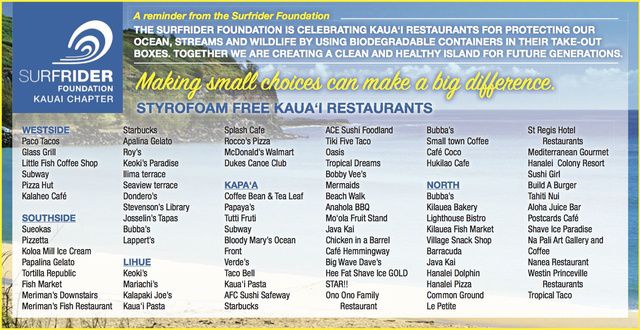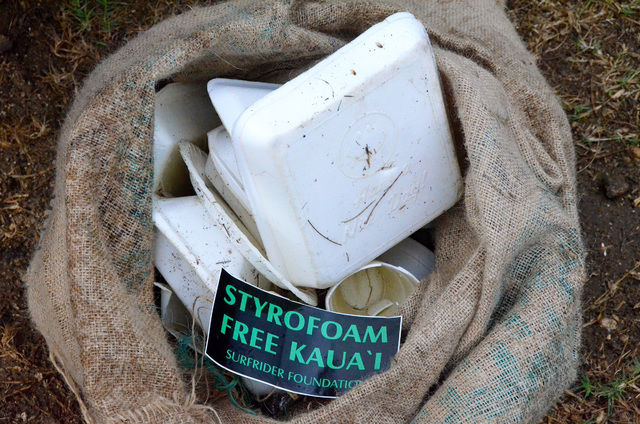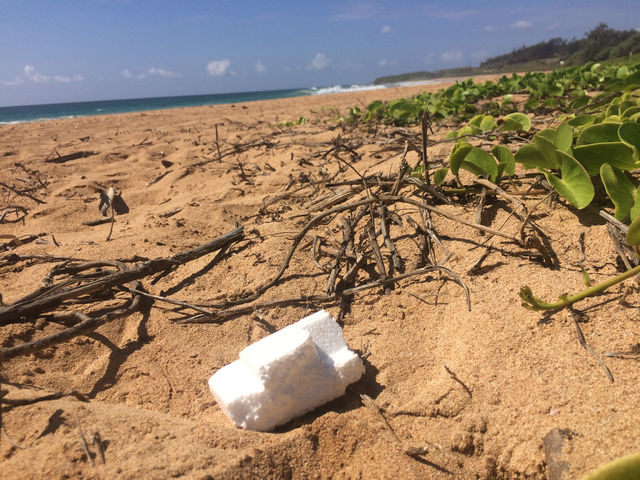KILAUEA — When Sandy Zietz discovered Kauai’s chapter of Surfrider Foundation had named Kilauea the first Styrofoam-free community in Kauai, she was ecstatic. “That’s great. More places should be Styrofoam-free,” she said. Shastin Snyder, who works at Healthy Hut with
KILAUEA — When Sandy Zietz discovered Kauai’s chapter of Surfrider Foundation had named Kilauea the first Styrofoam-free community in Kauai, she was ecstatic.
“That’s great. More places should be Styrofoam-free,” she said.
Shastin Snyder, who works at Healthy Hut with Zietz, said she’s also proud to be part of a community — and a business — that has given the boot to polystyrene foam, known by the popular brand name Styrofoam.
Polystyrene foam is a type of plastic product that is petroleum based, which means it comes from oil. According to the Environmental Protection Agency, the substance is the fifth-highest source of hazardous waste in the world and it can take about 500 years to decompose.
It is also a single-use product. By volume, polystyrene takes up 25 to 30 percent of the world’s landfill space.
“It doesn’t break down and you can’t keep recycling it like glass or paper,” Snyder said. “There’s other alternatives and it’s great that all the businesses here are using them.”
Zietz pointed out that alternative packaging materials are usually priced a little higher than their polystyrene counterparts, but she said that the community has spoken when it comes to their to-go containers.
“The community is willing to pay a little extra to get containers that aren’t made out of Styrofoam,” Zietz said.
Snyder said not only are customers willing to dish out another dollar, most of the time they demand it.
“Many people here in Kilauea are very passionate about the environment,” she said. “They’re asking for Styrofoam-free and biodegradable packaging.”
Robert Zelkovsky, Surfrider Kauai’s publicity and membership coordinator, said that’s the reason the group chose Kilauea as the epicenter for the movement to rid Kauai of polystyrene foam entirely.
The organization took on the National Surfrider’s Rise Against Plastic campaign about three years ago. It was a landfill teeming with trash and roadways lined with litter that prompted members to take action.
Zelkovsky said they started with a survey of the restaurants on Kauai. At that time, 30 percent of the 270 restaurants questioned did not use polystyrene foam.
All of the restaurants in Kilauea are now polystyrene foam-free.
Zelkovsky said Surfrider Kauai has met with Zero Waste Kauai and members of the County Council, who have voiced interest in the possibility of putting forward a bill to ban polystyrene products from the island. The mayor’s administration also supports the idea, but Mayor Bernard P. Carvalho Jr. said the county’s focus isn’t currently on creating new programs.
“Having a Styrofoam-free Kauai is a good version, and maybe we’ll get there in the future,” Carvalho said. “However, with our limited resources, we are currently focusing our efforts on managing our many existing diversion programs.”
Carvalho pointed out that the county’s recycling office has achieved a 44 percent diversion rate and that the latest major initiative, Pay As You Throw, was launched last year and he is looking forward to seeing the results. The program offers a variable rate for refuse fees and “has proven to significantly reduce waste destined for landfills by providing an economic incentive to reduce waste.”
The members of Surfrider Kauai, however, are focused on nixing polystyrene.
“Like the single-use plastic bag ban, there will be push back, but hopefully the health of the environment will prevail,” Zelkovsky said. “We see more restaurants voluntarily changing, and, as more do, prices for compostable (packaging) will go down.”
As soon as the group gets permits for signage, Surfrider Kauai plans to place signs in Kilauea recognizing the town as Styrofoam-free.




